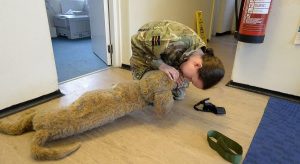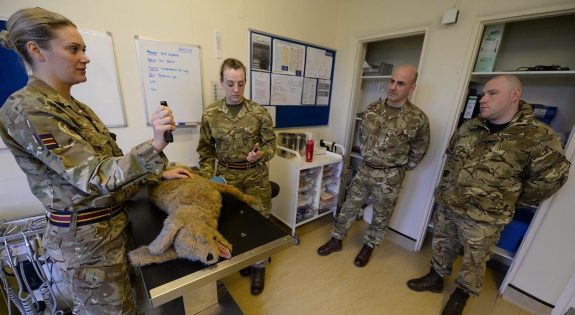News
February 14th 2019
Army dog handlers sharpen their skills
A receptionist, a mother and a lorry driver found themselves giving First Aid to three dogs and evacuating a further two to safety.
The trio, all reservists with 101 Military Working Dog Squadron, were taking part in a weekend training exercise at their base in St George’s Barracks, North Luffenham.
The dogs receiving first aid were life-like manikins that provided realistic training to learn first aid techniques whilst practicing them safely. The full-size manikin dogs feature working lungs, an artificial pulse and features to enable splinting and bandaging.
The vets who delivered the training could also release simulated blood and change pulse rates, all of which added to the realism of the training.
Exercises and lectures completed by the dog handlers included emergency CPR, assessment and First Aid and checking a dog for pain.

A reservist demonstrating mouth to snout technique
Lieutenant Tessa Muir (32), who in civilian life is a vet working as the Anti-Doping Manager for the British Horse Racing Authority, delivered a lesson on pain relief.
She said: “Whilst we don’t expect military dog handlers to diagnose the cause of the pain, it’s about being astute and identifying sometimes really subtle signs or maybe something that may not be normal for that dog and therefore knowing when to ask for further assistance.”
Lieutenant Muir spoke to the soldiers about the types of pain relief available for the dogs when the handlers are in the kennels or out on a training area and also talked about physiotherapy and hydrotherapy.
She joined the Army Reserves two years ago: “For me it’s about the animals, I think with working animals we have a particular responsibility to ensure we treat them appropriately and that they get the right care. It’s something I am very passionate about, so anything that I can add to ensure the animals well-being is great.
“And whilst I’m a vet, I’m also a troop commander, so for me it’s also about being a good role model. I get a lot of satisfaction from helping our soldiers and seeing them develop. It’s a fantastic thing to be able to do.”
The Squadron used Golden Retriever Bella and Rex, a Belgium Malinois, to practise carrying a dog without causing them or the dog injury.
Captain James Wright, the Second-in-Command of the Squadron works as a critical care vet in a veterinary hospital. He said: “We wanted to give our dog handlers a deeper insight into treating their dogs. If they deploy and something happens to their dog, they will know what to do without a second thought. Just training the basics means, should they need to, they can think back, know they can do it and just do it. It also keeps the training varied and gives them key skills.

Practicing bandaging wounds
“The assessment stage was monitoring all the vital signs for a dog. If you don’t know what’s normal, how do you know something is abnormal? They’ve now had a feeling of what abnormal feels like.”
He continued: “Casualty evacuation drill saw the handlers learn new techniques to carry the dogs if required including the fore-and-aft lift and lifting the dog over the shoulder.”
The nationally-recruited Squadron is the only Reservist dog-handling squadron in the Army. It forms part of 1st Military Working Dog Regiment (Royal Army Veterinary Corps) that provides the only deployable military working dog and veterinary service within the British Army. The dogs and their handlers provide vital detect and protect capabilities for troops on the ground.
Reserves joining the squadron are trained as Protection Military Working Dog Handlers looking after the security and safety of military assets and bases. Later on in their careers, there are opportunities to undertake specialist dog handler courses including vehicle search. The Regiment also recruits reservist Veterinary Officers.
"For me it's about the animals, I think with working animals we have a particular responsibility to ensure we treat them appropriately and that they get the right care. It's something I am very passionate about, so anything that I can add to ensure the animals well-being is great."

